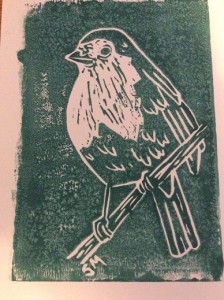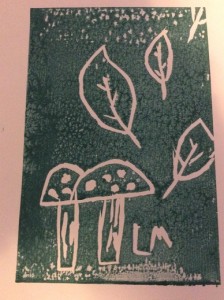
The personal benefits we can draw from nature are huge. I find nature itself an endless source of joy and inspiration for my teaching but more importantly in my life itself. Recently whilst quietly observing and sketching a robin that regularly visits my garden I became aware of its large keen eyes, the striking rusty red bib that extends over its face and chest, and its familiar round body shape when it ruffles up its feathers. I was able to express my sense of awe and wonder by designing a lino print based on these sketches.
We can all gain inspiration from looking closely at nature – even in the bleak mid-winter. Drawing outdoors teaches us to be still, to be observant and respectful to living things. You’ll be amazed at how well people can draw when given time and space in nature. Here are some tips to help you and your group get creative.
Tips for drawing outdoors:
- You will need to be comfortable to get your eye in, so pack suitable clothing for the weather, raincoats, walking boots and a woolly hat are essential at this time of year; an old camping mat cut into quarters is perfect for sitting on.
- Use a large waterproof container to store your art supplies (it’s very easy to lose equipment amongst fallen leaves). You’ll need a sketch book / drawing paper and board, an eraser, sketching pencils and pencil sharpener.
- Explore your surroundings to find objects to draw. Encourage the group to be open-minded and to be led by their curiosity. Leaves, simple shells and feathers are suitable for younger children. Older students and adults may enjoy the challenge of more complicated plants, lichens or pine cones. Use a magnifying lens to study small details and look through blank photo frames to help focus a composition.
- During follow up sessions the group can be challenged to draw more detailed observations through a series of field sketches to study animal movement and behaviour. These can be used back home or the classroom for reference for a final drawing or painting.
- Don’t collect wildflowers or living creatures to study. A digital camera is the perfect tool to record observations: landscape, movement and macro detail. Images can then be enlarged to help with identification. This works especially well for studying invertebrates and fungi where there are thousands of different species.
- A combination of photographs, drawings and field notes; species name, tracks and signs, habitat, behaviour; helps to maximize learning about a species that has sparked an interest. Use field guides and the Internet to research and support further learning. Drawings can inspire lively creative writing or used to create a field guide or nature book ……these ideas will be explored in the next blog post.
Remember drawings don’t need to be perfect. Trust your eyes and draw what you see – relax and enjoy!

